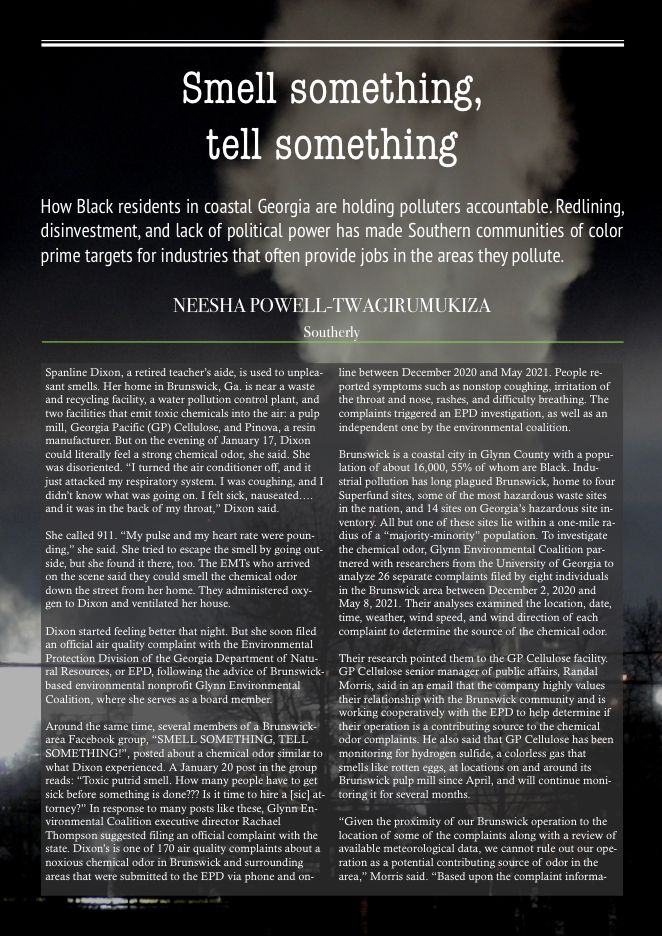 Spanline Dixon, a retired teacher’s aide, is used to unpleasant smells. Her home in Brunswick, Ga. is near a waste and recycling facility, a water pollution control plant, and two facilities that emit toxic chemicals into the air: a pulp mill, Georgia Pacific (GP) Cellulose, and Pinova, a resin manufacturer. But on the evening of January 17, Dixon could literally feel a strong chemical odor, she said. She was disoriented. “I turned the air conditioner off, and it just attacked my respiratory system. I was coughing, and I didn’t know what was going on. I felt sick, nauseated…. and it was in the back of my throat,” Dixon said. She called 911. “My pulse and my heart rate were pounding,” she said. She tried to escape the smell by going outside, but she found it there, too. The EMTs who arrived on the scene said they could smell the chemical odor down the street from her home. They administered oxygen to Dixon and ventilated her house. Dixon started feeling better that night. But she soon filed an official air quality complaint with the Environmental Protection Division of the Georgia Department of Natural Resources, or EPD, following the advice of Brunswick-based environmental nonprofit Glynn Environmental Coalition, where she serves as a board member. Around the same time, several members of a Brunswick-area Facebook group, “SMELL SOMETHING, TELL SOMETHING!”, posted about a chemical odor similar to what Dixon experienced. A January 20 post in the group reads: “Toxic putrid smell. How many people have to get sick before something is done??? Is it time to hire a [sic] attorney?” In response to many posts like these, Glynn Environmental Coalition executive director Rachael Thompson suggested filing an official complaint with the state.
Spanline Dixon, a retired teacher’s aide, is used to unpleasant smells. Her home in Brunswick, Ga. is near a waste and recycling facility, a water pollution control plant, and two facilities that emit toxic chemicals into the air: a pulp mill, Georgia Pacific (GP) Cellulose, and Pinova, a resin manufacturer. But on the evening of January 17, Dixon could literally feel a strong chemical odor, she said. She was disoriented. “I turned the air conditioner off, and it just attacked my respiratory system. I was coughing, and I didn’t know what was going on. I felt sick, nauseated…. and it was in the back of my throat,” Dixon said. She called 911. “My pulse and my heart rate were pounding,” she said. She tried to escape the smell by going outside, but she found it there, too. The EMTs who arrived on the scene said they could smell the chemical odor down the street from her home. They administered oxygen to Dixon and ventilated her house. Dixon started feeling better that night. But she soon filed an official air quality complaint with the Environmental Protection Division of the Georgia Department of Natural Resources, or EPD, following the advice of Brunswick-based environmental nonprofit Glynn Environmental Coalition, where she serves as a board member. Around the same time, several members of a Brunswick-area Facebook group, “SMELL SOMETHING, TELL SOMETHING!”, posted about a chemical odor similar to what Dixon experienced. A January 20 post in the group reads: “Toxic putrid smell. How many people have to get sick before something is done??? Is it time to hire a [sic] attorney?” In response to many posts like these, Glynn Environmental Coalition executive director Rachael Thompson suggested filing an official complaint with the state.
Dixon’s is one of 170 air quality complaints about a noxious chemical odor in Brunswick and surrounding areas that were submitted to the EPD via phone and online between December 2020 and May 2021. People reported symptoms such as nonstop coughing, irritation of the throat and nose, rashes, and difficulty breathing. The complaints triggered an EPD investigation, as well as an independent one by the environmental coalition. Brunswick is a coastal city in Glynn County with a population of about 16,000, 55% of whom are Black. Industrial pollution has long plagued Brunswick, home to four Superfund sites, some of the most hazardous waste sites in the nation, and 14 sites on Georgia’s hazardous site inventory. All but one of these sites lie within a one-mile radius of a “majority-minority” population. To investigate the chemical odor, Glynn Environmental Coalition partnered with researchers from the University of Georgia to analyze 26 separate complaints filed by eight individuals in the Brunswick area between December 2, 2020 and May 8, 2021. Their analyses examined the location, date, time, weather, wind speed, and wind direction of each complaint to determine the source of the chemical odor. Their research pointed them to the GP Cellulose facility. GP Cellulose senior manager of public affairs, Randal Morris, said in an email that the company highly values their relationship with the Brunswick community and is working cooperatively with the EPD to help determine if their operation is a contributing source to the chemical odor complaints. He also said that GP Cellulose has been monitoring for hydrogen sulfide, a colorless gas that smells like rotten eggs, at locations on and around its Brunswick pulp mill since April, and will continue monitoring it for several months.
“Given the proximity of our Brunswick operation to the location of some of the complaints along with a review of available meteorological data, we cannot rule out our operation as a potential contributing source of odor in the area,” Morris said. “Based upon the complaint information shared with us, our daily operations data does not indicate irregularity with our emissions that would correlate with the nature, timing and pattern of the citizen complaints.” The EPD identified a Clean Air Act violation at GP Cellulose last April involving nitrogen dioxide, one of several incurred by the corporation over the years. Nitrogen dioxide and hydrogen sulfide are two toxic chemicals emitted by GP Cellulose; others include ammonia, nitrous oxide, and sulfur dioxide. Over time, emitting these chemicals into the air can cause major health consequences to humans, including a higher risk of heart disease, respiratory disease, certain types of cancer, and birth outcomes. The university and Glynn Environmental Coalition plan to release their findings in a report later this month. Thompson said her group will use it to continue organizing city officials and local polluting industries to help resolve community concerns about air quality. They’re advocating for the EPD to monitor Brunswick’s air for sulfur dioxide, nitric oxide, and nitrogen dioxide. The agency currently only monitors the city’s air for particulate matter—PM 2.5—and ozone.
Additionally, the coalition is building an “air quality toolbox” that will include an online complaint portal and an anonymous tip hotline to make it easier for community members to submit air quality complaints to the EPD and the EPA and to track information the EPD withholds from the public. EPD director of communications Kevin Chambers said in an email that, agencies are able to withhold information related to a pending investigation of unlawful activity until the investigation is closed. Since the EPD is nearing the end of its air quality investigation in Glynn, they’ve released details of closed complaints “to assist the community in their understanding of the issue.” The agency used meteorological data, modeling, odor complaint information, and onsite inspections, yet did not make a definitive determination of the source of the chemical odor. “Odor investigations are difficult in nature due to a multitude of factors,” Chambers said. The unusually harsh chemical odor that invaded Brunswick and Dixon’s home has mostly subsided, but there’s no course of action to prevent it in the future. The complexity of this issue underscores the necessity of local monitoring by community members and organizations, according to some researchers.
Dr. Christina Hemphill Fuller, an associate professor in Georgia State University’s School of Public Health, researches the effects of air pollution on communities of color. She said communities are using tools like low-cost sensors and smartphone apps to monitor local air pollution. For example, the advocacy nonprofit Air Alliance Houston’s community-based air monitoring network uses low-cost sensors in Latinx and Black neighborhoods near oil and gas refineries in the Houston area. “Part of my research is understanding that the regulatory monitors that are out there aren’t protective of public health in many areas because there’s just not enough of them to really understand where the pollution is in those highly impacted neighborhoods,” Hemphill Fuller said. “That’s why it’s important to do local monitoring.” Historically, redlining, disinvestment, and lack of political power has made Southern communities of color prime targets for industrial polluters, Hemphill Fuller said. According to a 2017 study, Black Americans are 75% more likely than white Americans to live next to a company, industrial, or service facility that directly affects their health or quality of life.
Air pollution is already taking its toll on Brunswick residents. Asthma was among the top six diseases self-reported by Glynn residents who responded to a 2019 community needs health assessment conducted by the Southeast Georgia Health System. According to the Georgia Department of Public Health, trachea, bronchus, and lung cancers were the third top cause of premature deaths in Glynn between 2013 and 2017. But getting rid of polluting industries to protect residents’ health is a nuanced issue in Brunswick, where 35% of the population lives in poverty. GP Cellulose and Pinova are two of the top employers in the city, employing 550 and 216 individuals, respectively. Some Brunswick residents would love to see the city’s manufacturing plants disappear, but it doesn’t make sense economically because they’ve supported local families, including many Black families, for generations. By advocating for these industries to adopt more modern technologies that discharge less pollutants, Thompson said Glynn Environmental Coalition is aiming to solve the question: “How do we get them to sustain our economy while also keeping our people healthy and safe?”
Dixon said city officials and governmental agencies are reluctant to hold industrial polluters accountable because of the jobs they bring: “They really don’t want to put the finger on any one particular industry and say, ‘You’re responsible for doing this. You need to do something about it.’ I know that it’s the bread and butter for a lot of people, and nobody wants to say, ‘We take responsibility for the odor.’” The neighborhood where Dixon lives, Magnolia Park, used to be a point of pride in Brunswick—home to Black doctors, lawyers, and postal workers. Today, it’s better known for its uphill battles with chemical and nuisance odors. Dixon hears about a lot of her neighbors dying from cancer and wonders whether their deaths are linked to air pollution.
“I feel like if this were a Caucasian neighborhood and community,” she said, “more would be done about it.”
Originally published
by Southerly
July 14,2021

